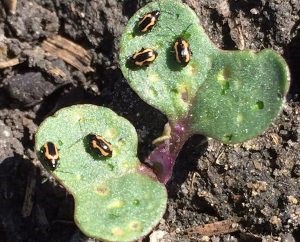Canola growers can take steps before or at seeding to improve crop competition against flea beetles. These include:
Residue management: Standing stubble protects soil from erosion and collects more snow. Stubble also improves flea beetle management by providing shelter from wind. With direct seeding, the remaining stubble can keep flea beetles feeding on leaves – and not down on the stems. A few bites on a leaf are far less damaging than a few bites on the stem.
Seed decisions: If growers have some wiggle room on last minute seed treatment decisions, they may upgrade their seed treatment. Enhanced insecticide seed treatments will improve flea beetle protection, especially when used in combination with the following management practices. Arrange a check strip comparison if you have two seed treatments on the same variety.
Aim for five to eight plants per square foot: This target is good for yield, and more plants mean fewer flea beetles per plant and more seed treatment per acre.
Take steps for fast emergence and more vigour: Rapid emergence and vigorous early-season growth can extend seed treatment protection until the four-leaf stage, which is generally considered to be the end of the flea beetle risk period. To achieve these objectives, seed shallow, at a reduced speed, into a warm, moist seedbed. Use only safe rates of seed-placed fertilizer. Our best recommendation is to use only phosphorus in the seed row and no more than 20 lb./ac. of actual phosphate. Higher rates of seed-placed fertilizer can add more stress, slow the pace of growth and reduce the plant stand.
Once the Crop Has Emerged
Even with all of these steps, flea beetle damage can still reach the economic threshold of 25 per cent leaf area loss across the field. If feeding is a concern, scout frequently, especially in warm, dry conditions that are ideal for flea beetles.
Flea beetles become active with the first extended period of warm weather in April and May. Striped flea beetles emerge from winter rest one to four weeks before the crucifer flea beetles, and it may take three weeks for all overwintering adults to emerge.
Canola Watch has good tips on the spray decision and tips to improve results. Please go to canolawatch.org/fundamentals, click on the Insects section and read “The flea beetle spray decision: 8 steps” and “How to assess leaf area loss from flea beetles”.
https://www.canolacouncil.org/canola-watch/fundamentals/the-flea-beetle-spray-decision-8-steps/
– Keith Gabert is a Canola Council of Canada agronomy specialist and a contributor to Canola Watch. Subscribe for the timely agronomy emails at canolawatch.org/signup.

